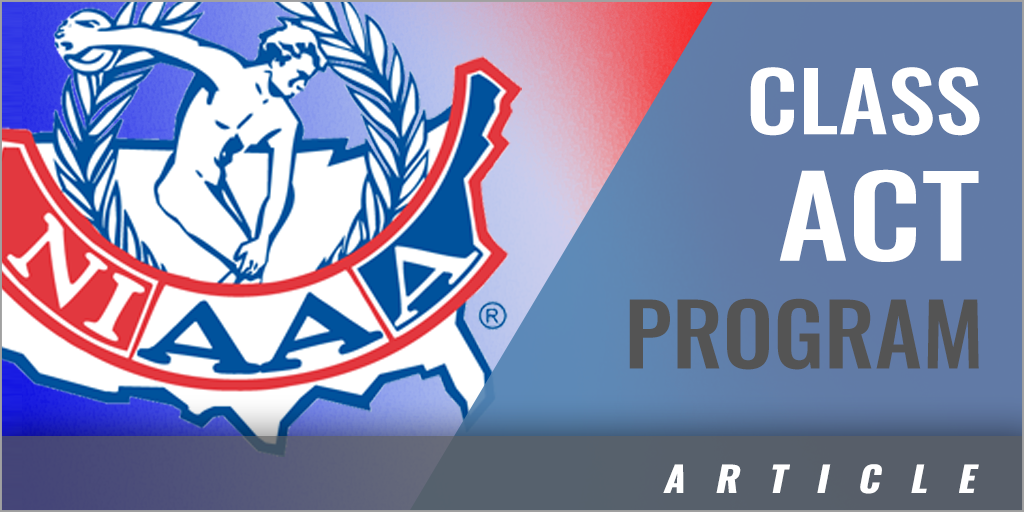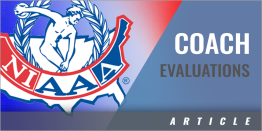|
By: Stephen Baldwin, CAA, Maureen F. Ruby, Ph.D., and Mel Horton, Ed.D. Class Act and the Connecticut Interscholastic Athletic Conference (CIAC) What is the Class Act Program? The Class Act Program in Connecticut is a framework of standards and guidelines set forth by the Connecticut Interscholastic Athletic Association (CIAA) which schools subscribe to follow. The program is designed to improve sportsmanship in school athletics. On the Class Act standards web page (Class Act Standards webpage here), the "standards" tab reveals responsibilities for the CIAC, athletic directors, spectators/parents, leagues, game personnel, athletes, and class act councils to aspire to and uphold. The Class Act initiative was launched in 2017 by Karissa Neihoff, in her role as executive director of the CIAC and Fred Balsamo, executive director of the Connecticut Association of Athletic Directors (CAAD). The program was developed as an outgrowth of the CAAD third strategic plan and was designed to empower and engage student - athletes in the development and enforcement of the standards. As described on the Class Act webpage, the CIAC "is committed to a philosophy of education - based athletics. "Class Act Schools agree "to strive" to achieve the standards outlined by the CIAC. Being a Class Act school is not a "designation" of achievement or an award. Rather, membership is a commitment to collaboration by everyone associated with the athletic program to being a better participant in the school's athletic program by following the standards and guidelines established and aligned with the principles of good sportsmanship. In Connecticut there are 11 designated leagues or geographically located groupings of schools. These leagues and their 155 Class Act members are identified under the "Schools" tab on the Class Act web page. Each Class Act school has a Class Act Council composed of students who meet regularly with their athletic director. Individual Councils develop mission statements. Student members determine the focus and work of their council. By establishing Class Act Councils, the Class Act School's program promotes engaging and supporting student athletes in developing leadership skills and taking ownership of and responsibility for sportsmanship in their school athletic programs. Class Act at Brookfield High School Brookfield High School (BHS) is a member of the South Western Conference (League) in a mid-sized district of 2,600 students, located in Fairfield County, Connecticut. BHS has 526 of its 871 students, roughly 60%, participate in athletics. Before Class Act existed, BHS had an athletic advisory which focused on sportsmanship and student leadership. The administration believed that student voice in athletics was important. Many students spend more time in their athletics activities than any other single aspect of their lives. It is important to honor student perspectives, promote their agency, and respect their voice. Sports are the perfect place for that to happen. The driving purpose of athletic advisory was to ensure BHS athletes' voices were heard, to empower the athletes to shape the athletic department, and to engage students in community service. Before Class Act existed, BHS had an athletic advisory which focused on sportsmanship and student leadership. The administration believed that student voice in athletics was important. Many students spend more time in their athletics activities than any other single aspect of their lives. It is important to honor student perspectives, promote their agency, and respect their voice. Sports are the perfect place for that to happen. The driving purpose of athletic advisory was to ensure BHS athletes' voices were heard, to empower the athletes to shape the athletic department, and to engage students in community service. Initially, the athletic advisory membership included the team captains. Almost immediately, other student athletes asked to join advisory. Students felt that most captains were seniors, and the group needed more representation and voice from underclassman and JV players. From the outset, students recognized the value of "belonging" and wanted to develop a culture of belonging for all. Thus, all students are now welcome as advisory members; however, attendance at regularly scheduled meetings and participation in an athletic advisory subcommittee is required. All members, the athletic director, and faculty advisor meet once per month. Six officers and faculty meet twice per month. Subcommittees meet independently. The subcommittees work on specific tasks and report on activities at full membership meetings and officer meetings as appropriate. When the CIAC launched Class Act, BHS became one of the inaugural Class Act schools. Since then, BHS has been a Class Act leader supporting other schools. BHS helps new members schools launch their own program. Members present at a variety of state athletic, sportsmanship, and leadership conferences on what it means to have a successful Class Act Advisory Council and BHS activities. BHS's Class Act efforts improve school and game culture and include simple, yet powerful, student identified activities. Our Class Act initiatives include implementing:
Athletic Advisory/Class Act Council Actions Pre/During/Post COVID Prior to the COVID-19 pandemic, our Athletic Advisory/Class Act Council was primarily a strong voice for decision-making and encouraging change and collaboration of all stakeholders to support positive school culture, good sportsmanship, and mutual respect. With the closure of schools in spring 2020, concerns mounted for the safety and well - being of all. During COVID, athletic advisory council members had ongoing check - in meetings on Zoom. Students voiced their personal challenges with isolation socially and academically, and shared concerns for other members of the BHS school community. They shared and processed their "lockdown" experiences and brainstormed solutions together. Athletic Advisory Council members expressed their struggles with online learning. In response, faculty advisors invited assistant superintendent Dr. Maureen Ruby to our Zoom meeting. She asked the students many questions about online learning and sought their input for change. With the help of a faculty member, students designed surveys to gather student input on how they were feeling about remote learning and what needs they had. Using the information from the meetings and the survey data, Dr. Ruby, BHS administration, and faculty implemented changes to address some of the student online learning challenges. Knowing the faculty listened and responded to student concerns about barriers to engagement, students were validated and empowered, as their voices were heard. Students collaborated with a school counselor to reach out to students struggling with loneliness and wellness concerns. Students saw how they influenced change at the school level. As a next step, BHS Athletic Advisory members actively engaged in a statewide television campaign to encourage students to abide by COVID health and safety recommendations and mandates surrounding masks. The TV ad can be viewed here: Connecticut High School Athletes Covid-19 PSA BHS Class Act 2.0 BHS's Athletic Advisory/Class Act Council has a legacy of success and works to support the well-being of student athletes. During the 2022-2023 school year, students discussed the fact that teachers in the district had been trained in the RULER approach (https://www.rulerapproach.org/) to supporting social-emotional learning (SEL). Students noted that there was no SEL training for their coaches. They felt coaches should also receive SEL training because students spend so much time with them. The council invited Dr. Ruby to meet with them to hear their concerns and brainstorm solutions, as she has expertise in SEL and originally implemented RULER in Brookfield. Dr. Ruby and her colleague Dr. Horton met with the council in the spring of 2023. Students shared concerns about the well-being of all athletes, including the pressures put on athletes for performance, perfection, and appearance, and the self-esteem of athletes who are not showcased or highlighted in competition. Dr. Ruby and Dr. Horton shared research on "belonging" with the council members. Belonging to a team or group is a part of a student's identity and is one of the basic human needs. Students have valued belonging since the inception of the athletic advisory when students advocated for the membership structure. To belong, individuals seek affinity groups where they are supported, connected, welcomed, trusted, befriended, and needed. Researchers have demonstrated that belonging is associated with improved health outcomes, increased academic success, motivation, decreased absenteeism, increased happiness, and general well-being (CASEL, n.d.b; Freeman et al., 2007; Hall, 2014). When families and friends of student athletes attend games, they also experience a sense of belonging. Participation in sports is generally associated with positive outcomes. However, the competitive characteristics of sports can have negative outcomes for some, including eating disorders, anxiety, and lowered self-esteem (Andersen et al., 2019; Zuckerman, et al., 2021). The need to belong and its relationship to identity and self-awareness make "belonging" and developing a culture of belonging a worthy focus for high school athletics and the well-being of student athletes. Council members independently explored the concept of "belonging" in the context of high school athletics using Erik Carter's belonging framework (Carter & Briggs, n.d.). Students used a belonging reflection tool to assess the status of the 10 dimensions of Carter's belonging framework in the BHS athletic program. They identified strengths and challenges and created an action plan to support student and adult SEL competency development. The plan had an intentional focus on the culture of belonging in the school athletic program. Plans for 2023-24 For the 2023-2024 school year, the council has established six subcommittees, each led by one of the six officers:
Next Steps: Belonging Project The Belonging Project subcommittee reviewed data collected using a survey tool that examines the 10 dimensions of belonging. It identifies what is going well and what needs improvement. The tool asks, "What actionable steps should we take next to ensure all students experience belonging in our school?" The subcommittee developed a comprehensive list from the data analysis. Next steps include collating the list, prioritizing needs, and developing an action plan to work on the prioritized items.
Class Act has empowered student athletes at BHS to have a voice, agency, and leadership roles in shaping and advancing their school community. Through advocacy, student athletes support sportsmanship and improve the mental health and well-being of student athletes by enhancing a culture of belonging. We look forward to sharing ongoing actions and results of the Class Act Athletic Advisory Group and supporting other schools in their efforts. References Andersen, M. H., Ottesen, L., & Thing, L. F. (2019). The social and psychological health outcomes. Health, doi: 10.1177/1403494818791405. Carter, E., & Briggs, E. (n.d.). Creating communities of belonging for students with significant cognitive disabilities. TIES Center. https://publications.ici.umn.edu/ties/peer-engagement/belonging/introduction CASEL: Collaborative for Academic Social and Emotional Learning. (2020). https://publications.ici.umn.edu/ties/peer-engagement/belonging/introduction What is SEL? CASEL: Collaborative for Academic Social and Emotional Learning. (n.d.). Transformative SEL. https://casel.org/casel-aasa-collaborate-to-support-district-leadership-with-social-and-emotional-learning/ Connecticut Interscholastic Athletic Conference. (n.d.). Class Act. https://ciac.fpsports.org/?page_id=10438 |






